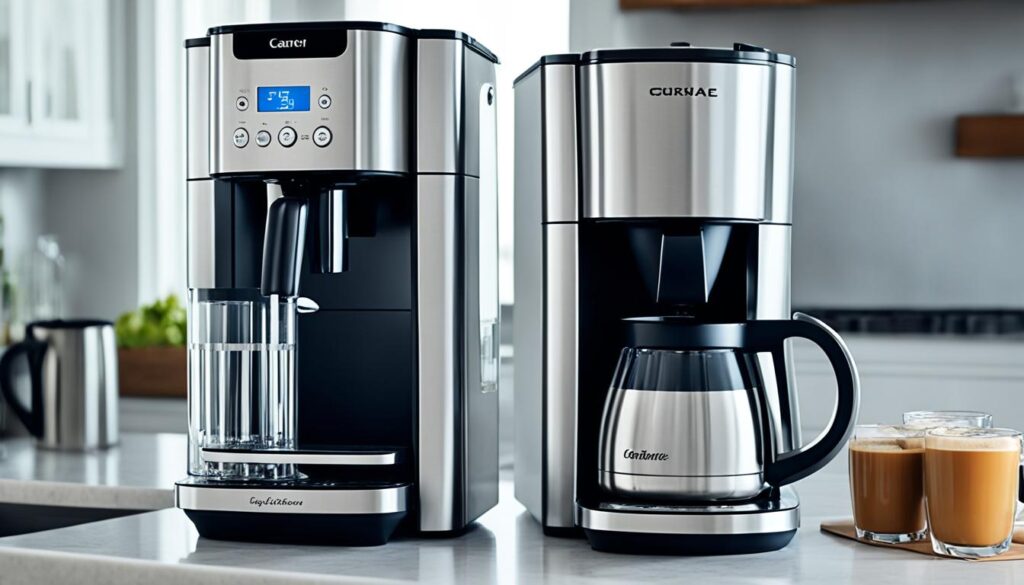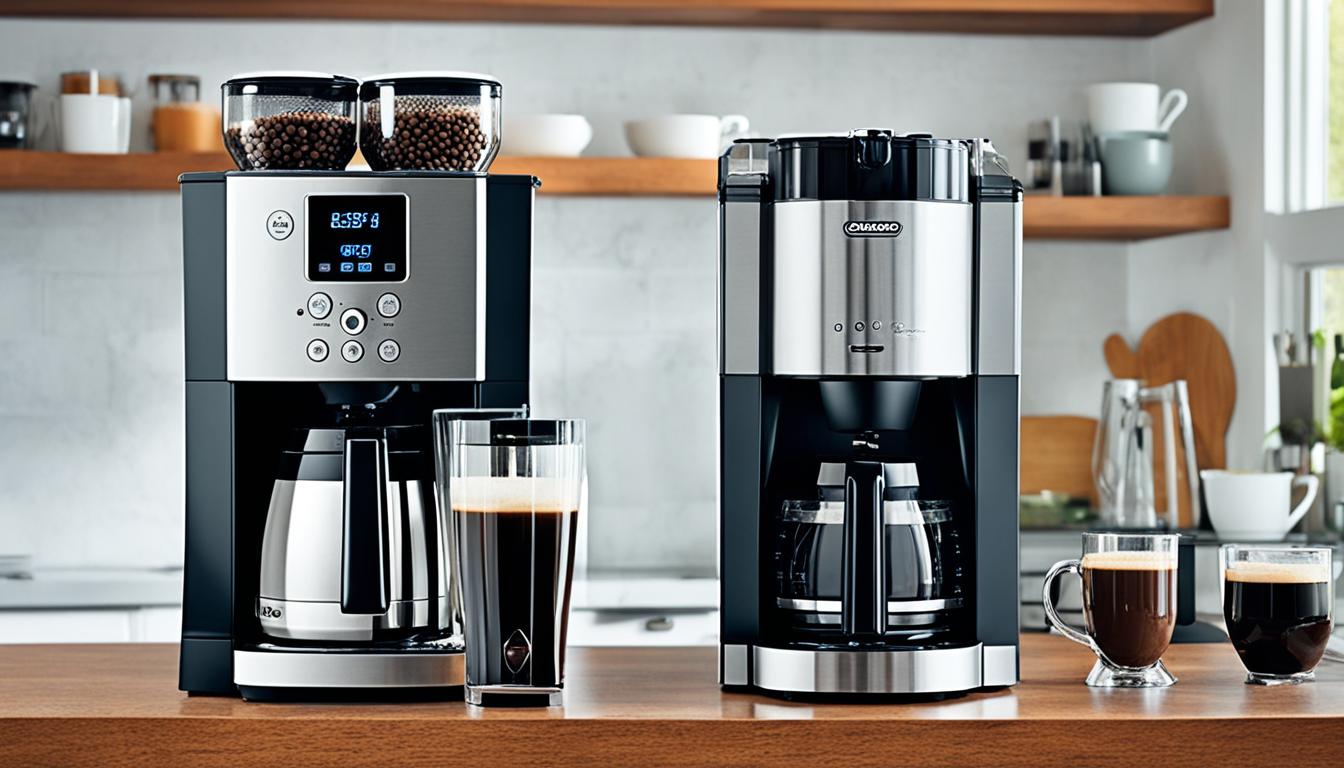Did you know that the global coffee maker market is estimated to reach a staggering $7.5 billion by 2027? This exponential growth underscores the immense popularity of coffee and the demand for high-quality brewing equipment. As coffee enthusiasts, we’re often faced with the dilemma of choosing between cheap and expensive coffee makers. But what exactly sets these two categories apart?
According to the factual data, there are significant differences between cheap and expensive coffee makers that impact the overall brewing experience and coffee quality. Cheap coffee makers, typically priced under $100, often use lower-quality components and lack advanced features, resulting in uneven extraction, inconsistent temperatures, and subpar coffee flavor. In contrast, expensive coffee makers, priced from $300 to $500 or more, are constructed with premium materials, high-powered heating elements, precise temperature control, and specialized spray head designs that deliver a consistent, optimally extracted cup of coffee.
The key differences lie in the power and heating elements, temperature control and stability, and spray head design for even extraction. High-end coffee makers also tend to have better build quality, repairability, and additional customization features like programmable bloom cycles. While more expensive, these advanced features and components justify the higher price tag for coffee enthusiasts seeking the best possible home brewing experience.
Unveiling the Key Differences
As we delve deeper into the world of
coffee makers
, it’s important to understand the key differences that set
affordable
and
high-end
models apart. From the power and heating elements to the precision of temperature control and the intricate spray head design, these factors play a crucial role in delivering the perfect cup of
coffee
.
Power and Heating Elements
The factual data reveals that cheap coffee makers are often equipped with lower-wattage heating elements, typically rated at 900 watts or less, which can take over 10 minutes to complete a full brew cycle. In contrast, premium coffee maker models like the Ratio Six, OXO Brew 8-Cup, and OXO Brew 9-Cup are all rated at 1400 watts, allowing them to heat water much faster and complete a brew cycle in around 5-6 minutes, in line with the Specialty Coffee Association’s home brewer standards. The design of the heating elements also plays a crucial role, with expensive models featuring cast aluminum coil heating elements that wrap around the chamber and heat the water to boiling in just a few seconds, while budget-friendly coffee makers often use less efficient horseshoe-shaped heating elements.
Temperature Control and Stability
The factual data highlights the importance of temperature control and stability in delivering the best coffee flavor. In testing, the high-end Ratio Six and OXO brewers were able to reach and maintain the optimal brewing temperature range of 195-205°F within the first 45 seconds of the brew cycle, and held those temperatures consistently throughout. Affordable coffee makers, on the other hand, took 2-3 minutes to reach a peak temperature of only 185°F, before spiking to as high as 210°F in the final minutes, which is too hot for optimal extraction. Precision temperature control and stability is achieved through extensive engineering and testing to account for factors like water line length, spray head design, and materials used in the brewer’s components.
Spray Head Design for Even Extraction
The factual data emphasizes the importance of the spray head design in ensuring even extraction and optimal coffee flavor. Cheap coffee makers tend to concentrate water towards the center of the coffee bed, leading to over-extraction of bitter flavors. In contrast, the Ratio Six and OXO brewers feature specifically engineered spray heads that evenly saturate the entire coffee bed during extraction. The Ratio Six has a metal spray head with a slight spiral pattern, while the OXO brewers use a trademarked “Rainmaker” design with channels that divert the water to each hole in the spray head. This level of engineering and testing on the spray head design is often not seen in more affordable coffee maker models.
cheap vs expensive coffee makers: The Build Quality Factor
When it comes to coffee makers, the build quality and materials used can make a significant difference in both the durability and performance of the appliance. Our research has uncovered some key insights that highlight the distinctions between affordable coffee makers and their more high-end coffee maker counterparts.
Materials and Construction
While budget-friendly coffee makers often feature a plastic exterior, the premium Ratio Six coffee maker boasts a sturdy, stamped stainless steel body. Additionally, the internal components of the Ratio Six, such as the borosilicate glass water supply lines, are designed for long-lasting cost-effective coffee brewers and ease of serviceability, with each part being easily replaceable. This level of attention to detail and build quality is typically lacking in more affordable coffee maker models, which are more likely to be discarded if something breaks.
Repairability and Warranties
The factual data reveals that high-end premium coffee machine brands, like the Ratio Six, are engineered with repairability in mind. With easily accessible internal components and screws, these luxury coffee maker models allow for DIY servicing, empowering users to maintain and extend the lifespan of their investment. In contrast, budget-friendly coffee makers are often not designed to be repaired, making them more prone to replacement if an issue arises. Furthermore, the Ratio Six and other value for money coffee machines come with extended warranty periods, often 5 years or more, providing users with peace of mind and assurance that their purchase will be protected.

Brewing Features and Customization
As we delve into the world of affordable coffee makers, high-end coffee makers, cost-effective coffee brewers, premium coffee machine brands, budget-friendly coffee makers, luxury coffee maker models, value for money coffee machines, and top-tier coffee maker options, it’s clear that the brewing features and customization capabilities play a crucial role in delivering the perfect cup of coffee.
Bloom Cycles for Enhanced Flavor
The factual data highlights the importance of the bloom cycle in achieving optimal coffee flavor. Both the Ratio Six and OXO brewers, recognized as premium coffee machine brands, feature built-in bloom cycles that automatically saturate the fresh coffee grounds, allowing the CO2 to be released and resulting in a more balanced, flavorful extraction. The OXO brewer even has a proportional bloom function that adjusts the bloom time and water volume based on the size of the brew, further enhancing the flavor profile. Cheaper, budget-friendly coffee makers often lack this specialized feature, resulting in less-than-optimal extraction and flavor.
Programmability and Brew Strength Options
The factual data reveals that high-end coffee makers like the OXO Precision Brewer offer a range of customization options that allow users to tailor the brewing process to their preferences. Features such as programmable timers, adjustable brew strength, and the ability to select different brewing modes (e.g., “Strong,” “Over Ice”) provide coffee enthusiasts with the ability to fine-tune their brewing experience. In contrast, cheaper, value for money coffee machines typically have fewer customization options, often limiting users to basic programming and brewing functionality. The advanced programmability and brew strength options found in premium coffee makers cater to the needs of discerning coffee drinkers who seek a more personalized brewing experience.
Balancing Cost and Performance
When it comes to choosing the perfect coffee maker, the decision often boils down to finding the right balance between cost and performance. The factual data suggests that coffee enthusiasts must carefully consider their individual needs and preferences to determine the most suitable option.
At the more affordable end of the spectrum, coffee makers under $100 can be a great choice for those who prioritize simplicity, portability, and a basic brewing experience. However, these budget-friendly models may sacrifice features like precise temperature control, even extraction, and long-term durability, which can impact the overall quality of your coffee. On the flip side, high-end coffee makers priced above $300 offer advanced brewing capabilities, premium construction, and additional customization options, but come with a significantly higher price tag.
Interestingly, the factual data also introduces a third option – the SimplyGoodCoffee brewer. This model aims to provide a balance between affordability and performance, delivering exceptional coffee flavor and quality at a more accessible price point of $149. For coffee enthusiasts who seek a cost-effective solution without compromising on features, the SimplyGoodCoffee brewer could be a compelling choice.
Ultimately, when it comes to selecting the best coffee maker, we must weigh the trade-offs and determine which features and price point best suit our brewing requirements and budget. Whether you opt for an affordable, high-end, or mid-range option, the key is to find the coffee maker that delivers the perfect balance of cost and performance to meet your unique needs.
